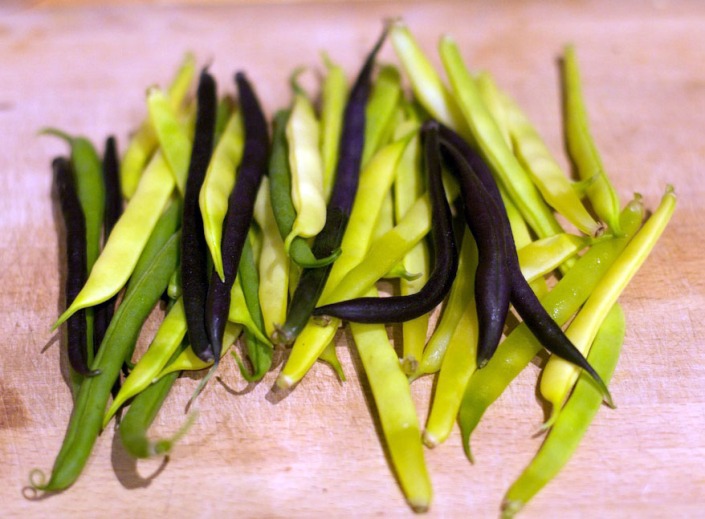Month: November 2009
Sunflowers in bloom

Sunflowers are good fun! We’re yet to work out the “grand plan” for the gardens at the front of the house, but we did have a spare patch of soil. In went sunflowers, four of which germinated. A few weeks ago flowers unfurled, bringing joy to everyone who walks by.
Seed saving tips from the Seed Savers Handbook: “Pick the heads when the petals have withered … Cut the heads, tie them in bundles and dry in the sun for a week or more … For a smaller crop, heads can be rubbed by hand. Clean the seeds by winnowing and sieving.”
Apparently the seeds will last up to 5 years when dried well. They can, of course, also be eaten!
We have pumpkins

Last week I was in Northern California for work, and pumpkins were everywhere. Piled up in fields, filling fruit vendor’s stalls, on window sills and beside doors. It was definitely the season for pumpkins.
I was therefore excited to come home to some pumpkins of our own. I stashed seeds in corners throughout the gardens, and all have been growing well. The smaller “Small Sugar” variety have been the stars, flowering early under large healthy leaves.
We’ve been getting the hang of hand pollination. The female flowers have a round bulb at their base (which becomes the pumpkin), and pollen from the male flowers is hand deposited onto them. The only challenge was that for the first few weeks we’d get one flower at a time, either male or female but never both. Very frustrating!
Still, we got there in the end, and have three pumpkins growing, with the promise of more. (We’re still waiting for our full-sized pumpkin plants to stop trying to take over the world, and to get on with producing fruit.)
Heartsease
Our heartsease plants have begun to flower. What is heartsease? THIS is heartsease:

I wanted to grow heartsease in the herb garden to add some interest and colour. Not only that, but the flowers and leaves are edible so they fit with my self-imposed rule of only planting edible plants in the herb garden.
Apparently heartsease has some health benefits too. However, the health benefits vary depending on what you read. Some places say it is good for remedying lung complaints (asthma etc). Others say that heartsease tea (made from dried and ground heartsease flowers and leaves) is great for sinusitis. Still others say the plant contains “cytotoxic characteristics” which apparently treats cancer.
Nevermind, I thought I’d try some heartsease tea made with fresh flowers to see if I would survive. The tea tasted like rocket. I am still alive, but not sure whether I’m feeling any better than I did prior to taking the tea! Anyway it’s an interesting experiment.

Oh, and finally I’ve read the flowers are a colourful addition to salads, so I think we’ll stick to that 🙂
This is how many beans we’re harvesting

The bean plants are really coming into their own! This is how many beans we’re harvesting each day or two, and we’re already creating a backlog in the fridge. We need to eat more beans! 🙂
Council gives Guerilla Gardeners a green light
Yarra Council in Melbourne has recently come out in support of Guerilla gardens in their municipality. This will set a precedent for other councils. Are you listening, Marrickville Council?
In the meantime:
As Rebecca Solnit, the inspiring San Francisco-based activist, concludes in her book Hope in the Dark: the Untold History of People Power, there is no point waiting for governments, be they local or otherwise, to initiate change.
She insists that it’s from the margins that new and radical ideas always emerge and get translated into action. And the margins are certainly where you’ll find guerilla gardeners.
Hat tip: New Matilda
Three colours bean

We’ve eaten our first beans tonight, in three colours: green, yellow and purple. The bean bushes are just ramping up at the moment, so plenty more to come!
I blanched these, and served them with olive oil, lemon juice, mint, feta and pine nuts. Yum.
Carrot jam

After pulling out the pile of carrots recently, we’ve been working hard to get through them. This included a carrot cake (yum!), and an Indian carrot salad (thanks Jamie Oliver!). The highlight, though, has to be carrot jam.
Yes, carrot jam.
When my grandmother came by, she extolled the virtues of this jam, declaring it to be remarkably delicious. We were doubtful, but keen to get rid of some more carrots. So we traded some carrots for a few jars of home-made jam.
I must say, we were surprised. The jam is great. It looks and tastes like orange marmalade, and couldn’t be easier to make. These are the ingredients (in imperial measurements, due to the age of the recipe):
- 4 carrots (grated)
- 3 pounds sugar
- 3 pints water
- 2 lemons (finely sliced)
Cook for one hour, and then bottle. Voila!
When our next carrot glut comes along, I’ll definitely give this a try. Carrot jam, who would’ve thought!
Update: my grandmother read my post, and apparently I got a few details wrong 😉 Initially, the ingredients are soaked in the boiling water overnight. Then, when cooking, keep going until the jam is setting properly, which may take more than an hour. (Take out a sample, and let it cool to see if it is “jam-like”.) Who says blogs are just for younger folks!